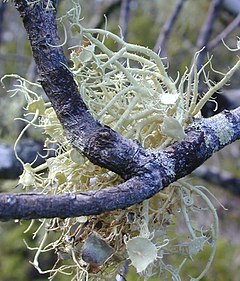Beard lichen
| Usnea | |
|---|---|
 |
|
| Usnea australis | |
| Scientific classification | |
| Kingdom: | Fungi |
| Division: | Ascomycota |
| Class: | Lecanoromycetes |
| Order: | Lecanorales |
| Family: | Parmeliaceae |
| Genus: |
Usnea Dill. ex. Adans. (1763) |
| Type species | |
|
Usnea florida (L.) Weber ex F.H.Wigg. (1780) |
|
| Species | |
|
See text. |
|
See text.
Usnea is a genus of mostly pale grayish-green fruticose lichens that grow like leafless mini-shrubs or tassels anchored on bark or twigs. The genus is in the family Parmeliaceae. It grows all over the world.
Members of the genus are commonly called old man's beard, or beard papa. It resembles Evernia, which is also called tree moss.
Like other lichens it is a symbiosis of a fungus and an alga. In Usnea, the fungus belongs to the division Ascomycota, while the alga is a member of the division Chlorophyta.
Members of the genus are similar to those of the genus Alectoria. A distinguishing test is that the branches of Usnea are somewhat elastic, but the branches of Alectoria snap cleanly off.lichen mostly lose family
As a fruticose lichen, Usnea appears as a shrub-like growth on host trees. Unlike other similar-looking fruticose lichens, species in this genus have an elastic chord or axis running through the middle of the thallus that can be revealed by gently pulling a filament apart from either end. It reproduces via vegetative means through fragmentation, asexual means through soredia, or sexual means through ascogonium and spermatogonium. The growth rate of lichens in nature is slow, but the growth rate has been sped up in laboratory conditions where Usnea is being cultured.Usnea looks very similar to the plant Spanish moss, so much so that the latter's Latin name is derived from it (Tillandsia usneoides, the 'Usnea-like Tillandsia').
...
Wikipedia
